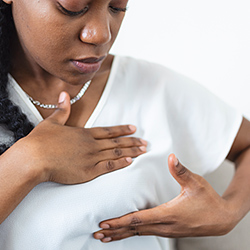
Many women will experience some type of breast symptoms or change during their lives, including lumps, swelling, infection, skin irritation, and various nipple issues such as nipple discharge.
“While these symptoms could be a sign of cancer, fortunately most are benign (noncancerous),” says Dr. Holly Mason, section chief, Breast Surgery at Baystate Health.
“Some conditions, however, do increase your risk for breast cancer while others do not. When a new breast symptom is identified, expert evaluation and care are needed to ensure that the cause of that symptom is not breast cancer,” she adds.
What is Benign Breast Disease?
Benign (non-cancerous) breast conditions are growths or changes to the breast tissue that are not cancer.
Dr. Mason notes that the changes women experience can occur at any time during their life, whether young or old.
“Many of these changes, such as pain, tenderness and lumps, are the result of hormonal changes around the time of your menstrual periods, during pregnancy, and again as menopause nears,” said Dr. Mason.
A look at the many types of breast problems that aren’t breast cancer include:
1. Breast Pain
There are many possible causes of breast pain including changes in the level of hormones during menstruation. Other causes are menopause, pregnancy and puberty, as well as some medications or even a poorly fitting bra that does not offer enough support. Using heat or ice, as well as over-the-counter pain medications, may help to alleviate the pain. Fortunately, breast pain is not a common symptom of cancer.
2. Fibroadenoma
One of the two most common types of benign breast disease, fibroadenomas are solid breast tumors made up of glandular and connective tissue. Fibroadenomas usually occur in younger, premenopausal women and don’t increase cancer risk as they do not arise from the ducts or lobules of the breast. A needle biopsy may be required to confirm the diagnosis. Whether or not a fibroadenoma needs to be excised depends on its size and if it is causing pain. Many fibroadenomas can be observed over time.
3. Cysts
Cysts, which are fluid-filled sacs that may cause pain and can be felt as a lump in the breast, are the second most common type of benign breast disease with about 25% of all breast masses turning out to be cysts. They often occur in women during their reproductive years or those who are premenopausal. They do not increase your risk of cancer and often disappear without treatment, although in some cases a needle aspiration may be needed to drain the cyst.
4. Mastitis
This condition occurs often during pregnancy when an infection sets in and your breast becomes red, warm and tender. Mastitis often occurs when a milk duct becomes blocked during breastfeeding. It is treated with antibiotics and over-the-counter medications to help with any pain. Sometimes an abscess may form as a result of the infection, and doctors may drain it using a needle or it may require surgery to be drained. It does not increase breast cancer risk. Causes of breast infections other than breastfeeding include smoking, trauma and nipple piercing.
5. Fibrocystic Breast Changes
Fibrocystic breast changes – occurring in women between the ages of 30-50 – are usually found in both breasts and are linked to hormones. They are often described as a lumpiness when felt in the breast. This may be due to small clusters of cysts, thickening of the breast tissue and swelling. Discomfort often occurs just prior to a woman’s period due to hormonal influences on the breast tissue. Fibrocystic breast changes do not increase your chances of getting cancer and often go away after menopause with no treatment needed.
When to Call Your Doctor
Women who see or feel something during their regular self-examination that is different than it was the previous month, should see if it is still there in two to three days. Changes in the breasts that go away in a day or two are common because of hormone levels during menstrual cycles. If the changed area is still there in two to three days, you should have it checked by a doctor.
The National Institutes of Health and Dr. Mason recommend calling your provider if you:
- Have a new, unusual or changing lump in breast tissue that persist
- Do not know how to properly perform breast self-examinations
- Are a woman, age 40 years or older, and have never had a screening mammogram
- Have discharge from your nipple, particularly if it is a bloody or brown discharge
- Have symptoms that interfere with your ability to sleep, and diet changes and exercise have not helped.
Your provider will take your medical history and perform a physical examination to check for lumps or other breast changes. A mammogram and/or breast ultrasound may be recommended to assess the breast. These tests will evaluate any abnormal finding on a breast exam. If a lump is found that is not clearly benign, you may need a breast biopsy.
To make an appointment
To make an appointment with a breast specialist, call 413-794-8899.
Learn more about breast care and wellness.